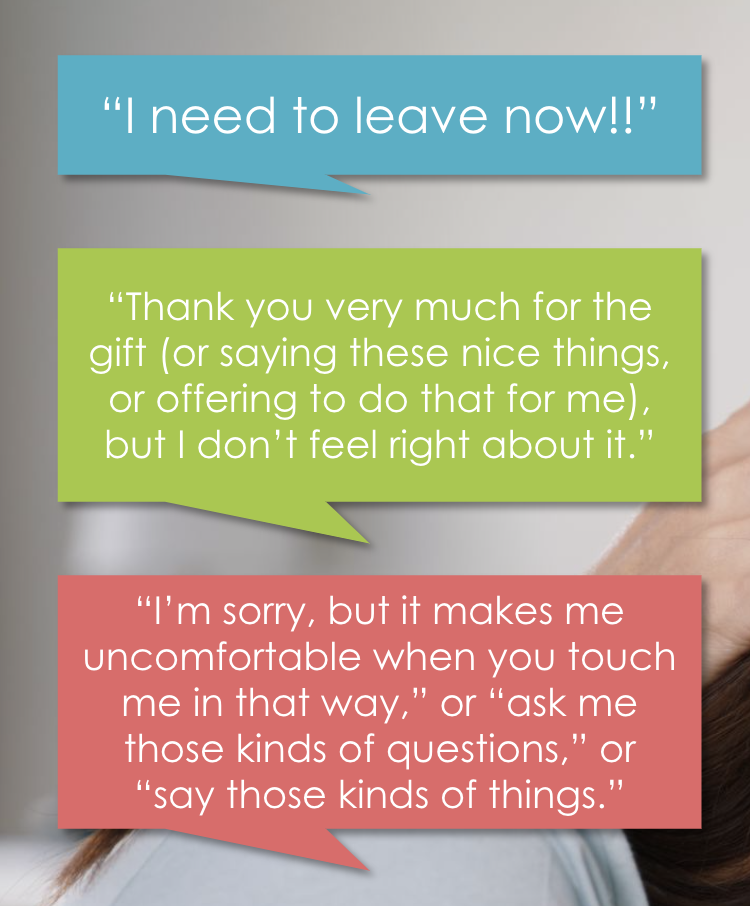Respecting Yourself and Others: Boundaries
When it comes to ensuring safety, some ways to reduce risk aren’t as easy as putting a helmet on when you ride a bike or wearing your seatbelt in the car. However, one effective way to protect your safety is to have a conversation where you clearly explain your boundaries to someone you trust and care about. A boundary can be an emotional, physical, or mental barrier that you choose to put in place with another person or a relationship you have in your life. We set boundaries to protect our mental and physical health, and it’s important to always respect others’ boundaries, as well as your own. Knowing your boundaries plays a key role in keeping your friendships and other important relationships happy and healthy.
How to Set Boundaries…
Understanding the different types of boundaries can help you support them more effectively as their Safe Adult and/or guardian. Learning what your child’s boundaries are and respecting them makes for a safe and confident environment for them to grow into…
There are three different types of boundaries that you can set for yourself: emotional, physical, and mental.
Emotional boundaries refer to how you handle or navigate situations regarding your well-being. An example of an emotional boundary could be, “I appreciate you spending time with me while we figure this out, but I’m feeling overwhelmed and need space.” Asking for any type of emotional support is just as important as asking for physical support.
A physical boundary could involve actions that someone does that affect you physically or your personal belongings. You might set a physical boundary if you’re uncomfortable when someone touches you a certain way or messes with your things. For example, if you don’t like how someone keeps taking your things without asking, you could say, “I don’t like it when you take my stuff without asking. If you need to borrow something, you can always ask me first. Please give it back when you’re done.”
Lastly, a mental boundary can help manage your thinking space in your relationship. You may need to set a mental boundary with someone if they are forcing you to share personal information you don’t feel comfortable sharing, or they keep invalidating your personal opinion and beliefs. The main difference between an emotional and mental boundary lies in the emotional versus the thinking aspect. You set emotional barriers to protect your emotions and mental barriers to protect your individual thoughts and/or way of processing information.

Setting boundaries never has to be a scary thing. Think of having boundaries in your relationships as guides to care for one another and how you all can grow closer together. Being honest with your friends and family is the best way to have these conversations and see common ground.
Let’s Talk About Consent…
Stating a clear difference between consent and boundaries can be crucial to keeping your child safe. These concepts can easily be confused, but as Safe Adults, it is important to reinforce this message with your child to ensure they understand that they can always say NO. This reading point can be a great way to pause and check in with your child about their understanding of what you just read, and check in on their peer and adult relationships they have in their lives…
When learning and understanding boundaries, it’s essential to be aware that boundaries and giving consent are not the same thing. Sharing a boundary with someone doesn’t mean you are automatically giving consent to this person. Although these terms are closely related, giving/receiving consent to/from someone will always be an entirely separate conversation from sharing your personal boundaries. We may often think of consent only in romantic relationships, but in reality, consent should be a part of any relationship in your life.
If someone is coercing you and threatening you to change your boundaries or give consent, that is not a real boundary and NOT real consent. We should never let anyone belittle us or make us feel guilty for setting boundaries in our relationships. You always have the power to say NO to anyone who is trying to convince you to shut down a boundary or give consent to them. We teach youth that if someone makes them uncomfortable or they Spot Red Flags in someone’s actions, reach out to a SAFE ADULT to receive help in taking the next step to separate themselves from this relationship.
Respecting Others Boundaries…
Youth may often look to their guardians or Safe Adults to see how to treat others. This section can demonstrate how building vital relationships in their lives means being respectful towards one another and always treating someone how they want to be treated…
The great part about having your boundaries is that they are unique to you, to make you feel your best mentally and physically. Someone like your best friend, teammate, or classmate might have different boundaries and other ways they would want to be treated. When you meet someone with different boundaries from your own, it is just as important to treat their boundaries as you would yours. We may not always know each other’s boundaries, so it’s important to have an open conversation and let your friends know ways you like to be treated to avoid conflict or any feelings hurt moving forward.
Over time, people’s boundaries can change, and that is totally normal! No boundary you create is ever going to be set in stone forever. Eventually, you’ll have to bring up that new boundary you’ve established for yourself to continue to grow in your relationships. When setting your own boundaries in place, it’s crucial that you never dismiss someone else’s. It is never okay to intentionally cross someone’s boundaries.
Crossed Boundaries…
Sometimes boundaries are unintentionally crossed; this section provides young people with practical language for responding. For families, this is a crucial moment to support children in voicing their feelings calmly and confidently. Parents can use this section to role-play scenarios or help their children recognize red flags in friendships or other relationships. By utilizing the MBF’s Five Safety Rules, your child can understand how to navigate these tricky situations and keep themselves away from any danger…
If anyone ever pushes past your limits and crosses a boundary you set with them, it’s best to vocalize your feelings and let the person know they made you feel upset. It is possible the person who crossed your boundary did it by accident, so when you voice your concern, they should apologize and not cross the same boundary again. But, if the person who crossed your boundary apologizes and continues to cross that same boundary, you may need to take action or Make a Move, such as creating space between yourself and this person, and spending time with different people in your life. It’s important that you respect your boundaries so others will respect them as well. If someone doesn’t care enough to protect your barriers, they might not have your best interests in mind, and it’s best to stay away from them if they keep hurting your feelings.
Respecting your loved ones’ boundaries while respecting your own is the equation for a healthy relationship! Protecting each other’s limits and barriers shows that you know how to listen to one another, value each other’s feelings, and build trust within one another. Setting boundaries is never creating a setback in your relationships, but rather furthering them by being honest with one another and letting your communication skills grow!

Additional Resources:
If you are in an emergency situation or are in need of family services, please contact your local authorities and/or child protection service agency.
CLICK HERE for list of Help Hotlines.




